Programming on Algorithmic Languages Week 1 1.

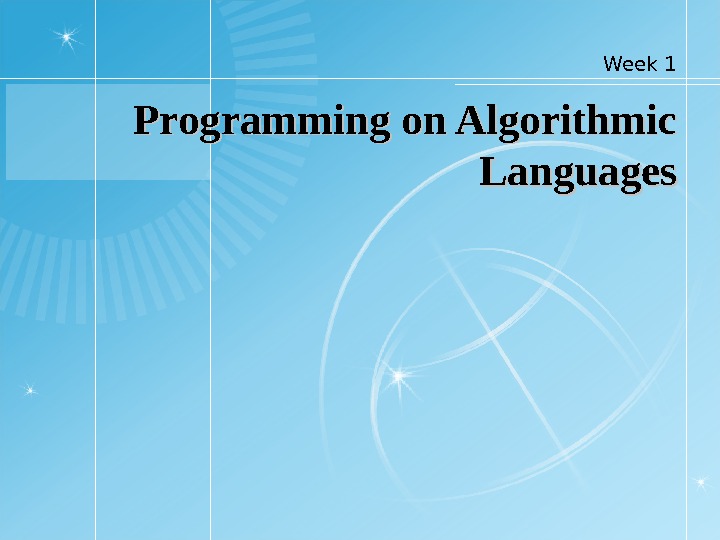
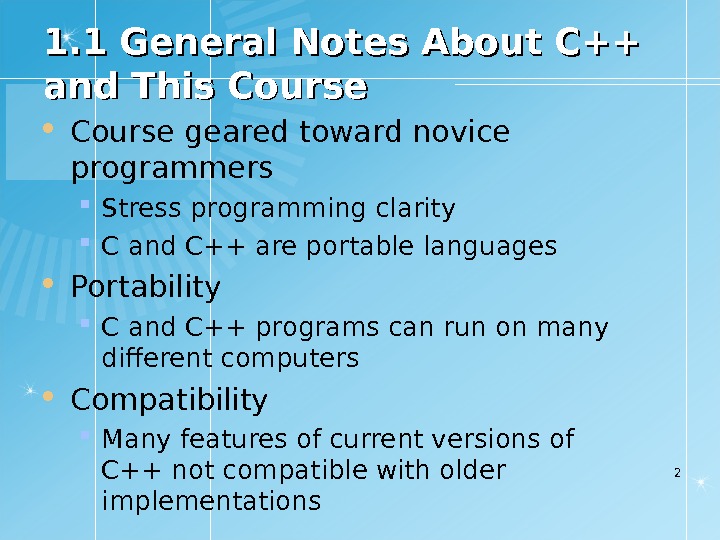
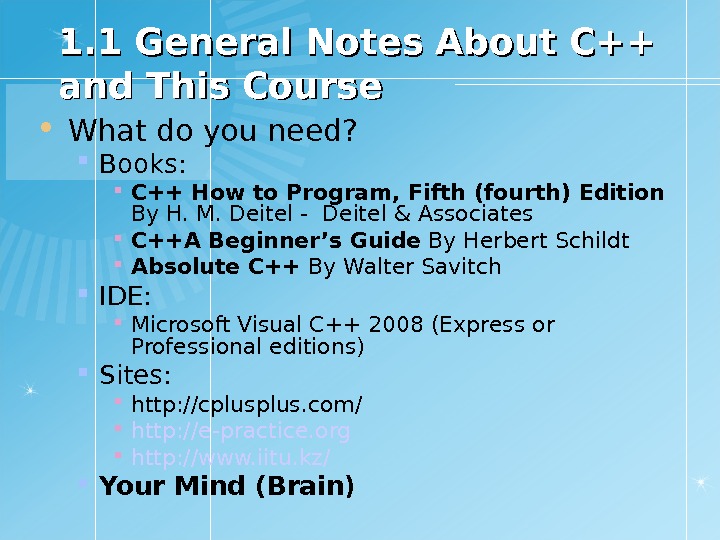
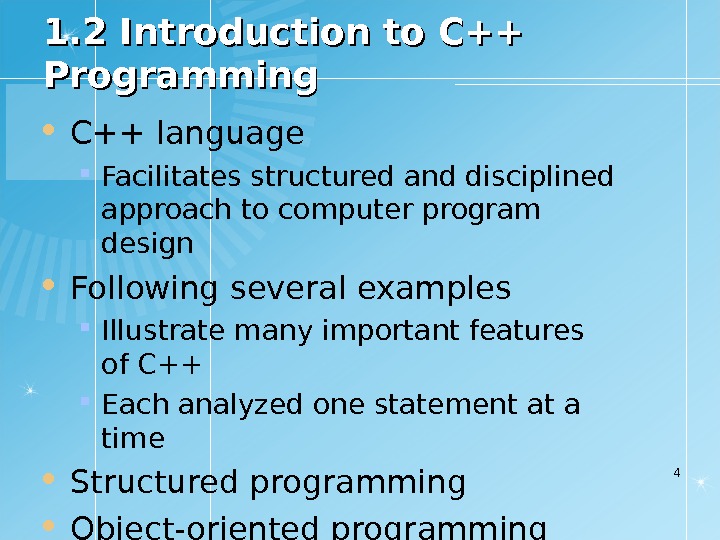
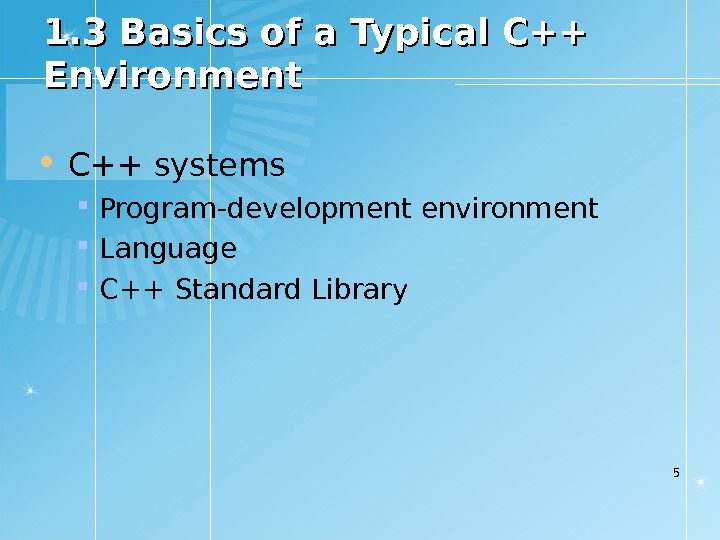
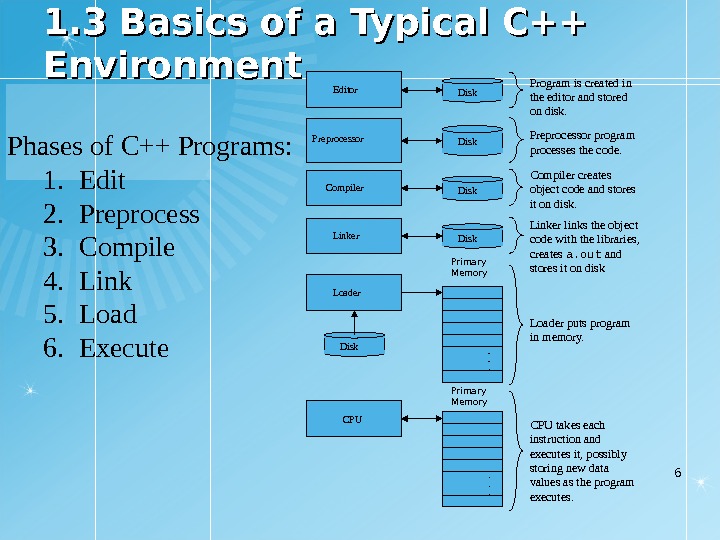
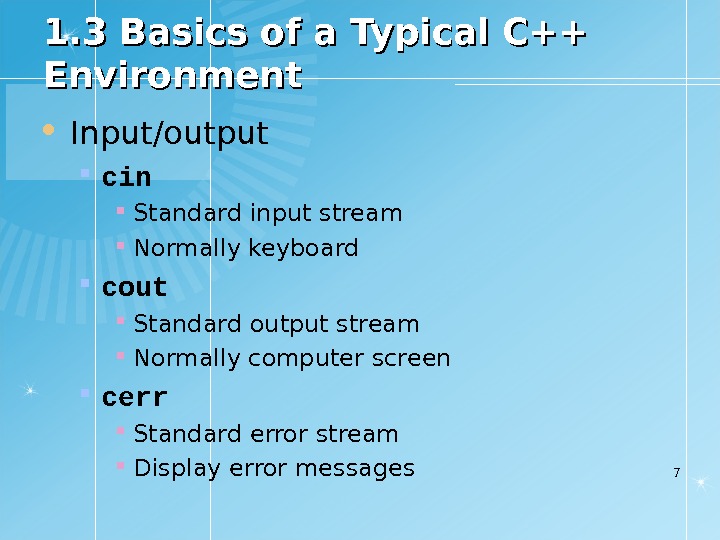
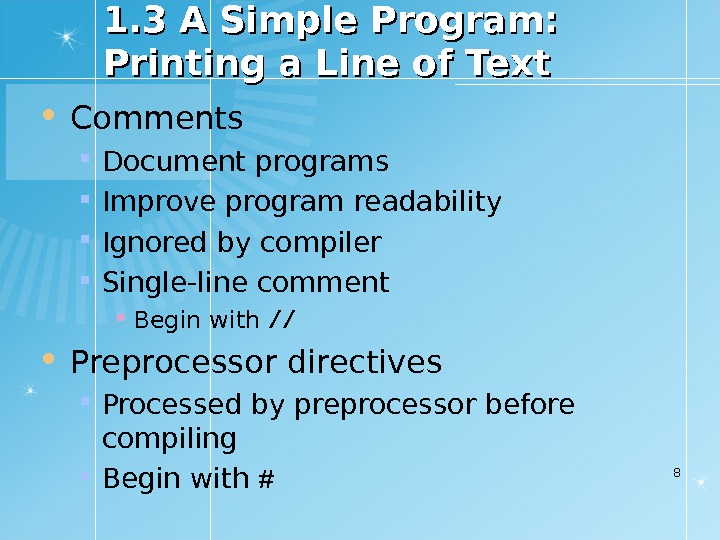
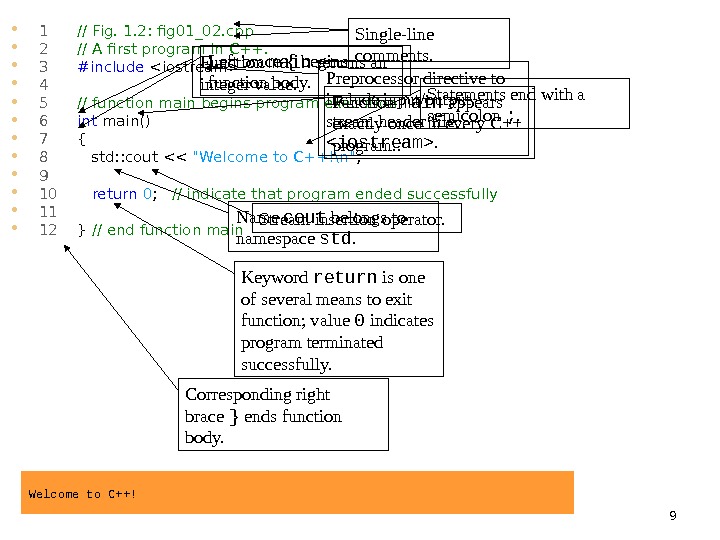
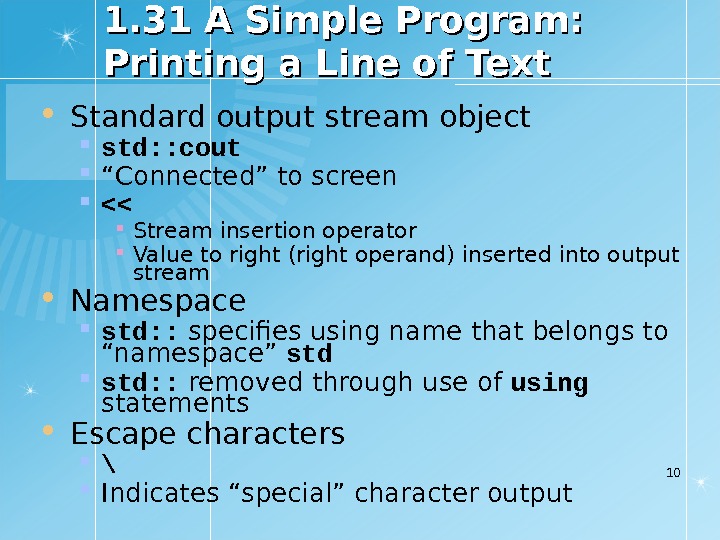
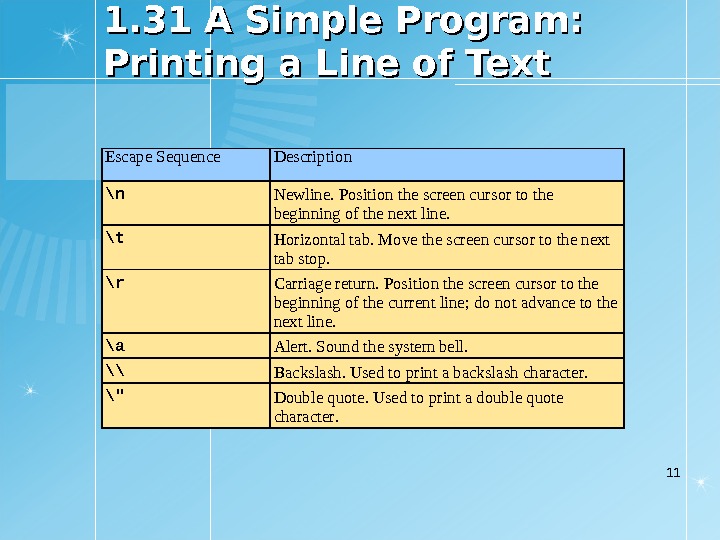
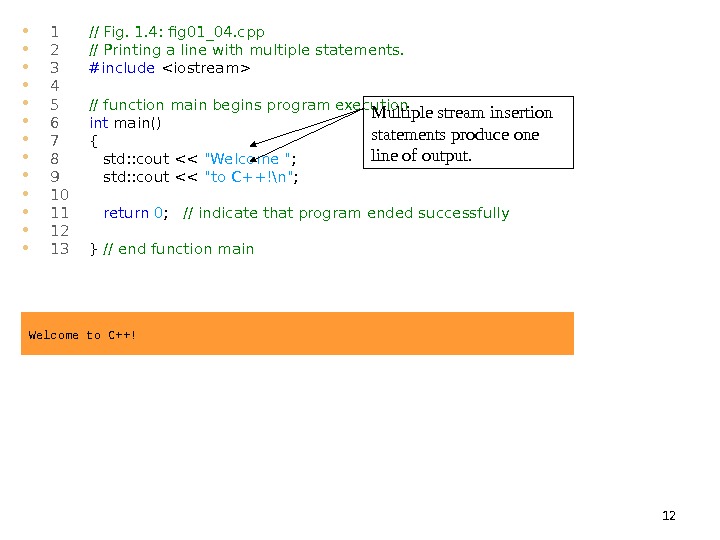
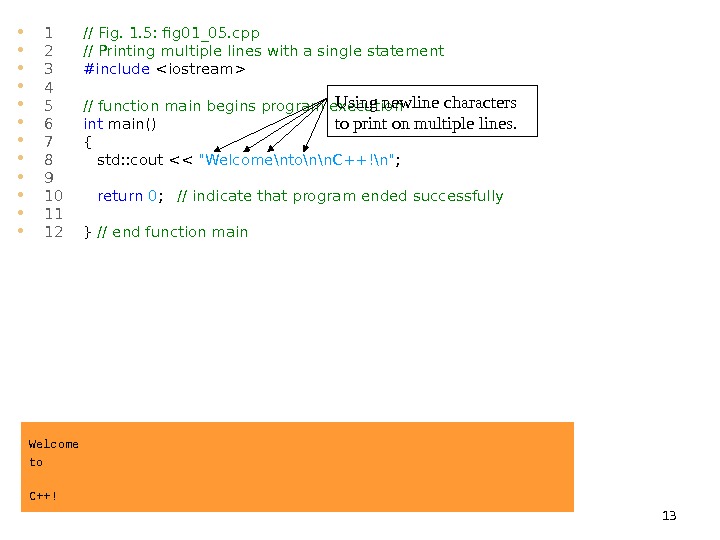
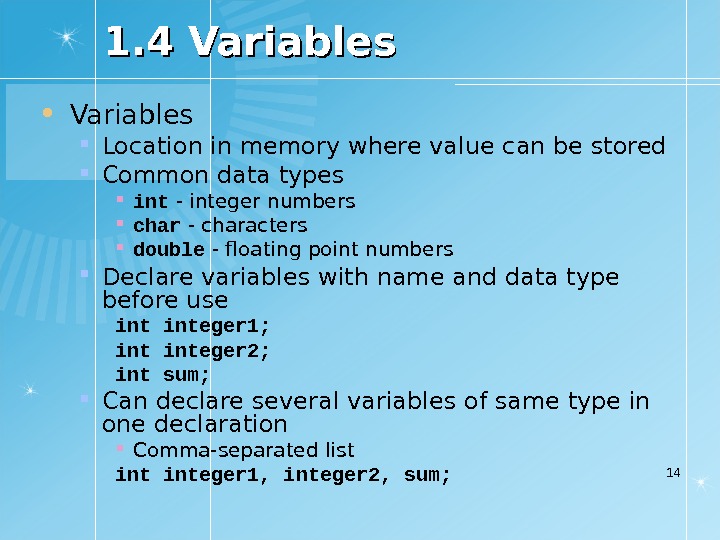
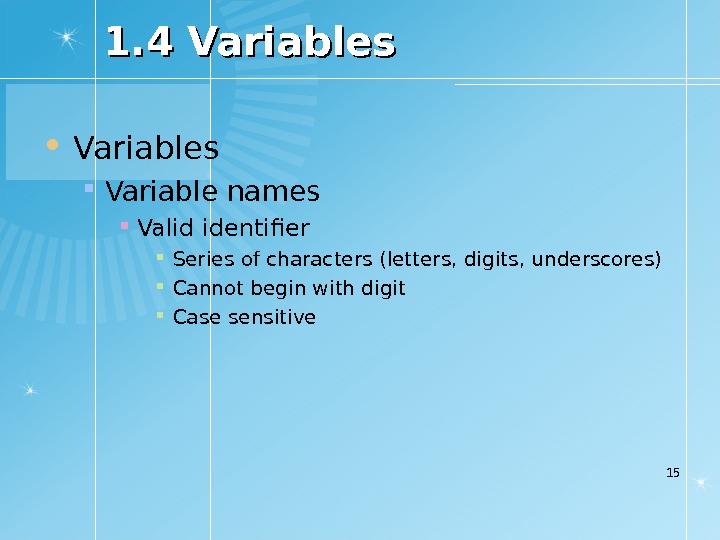
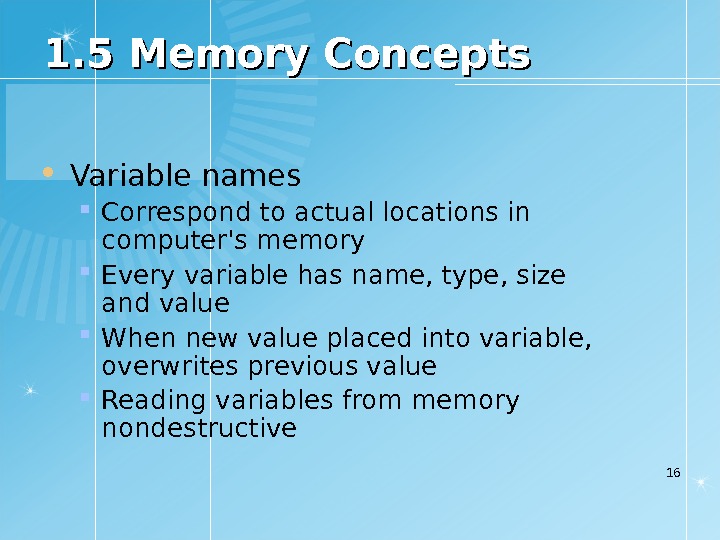
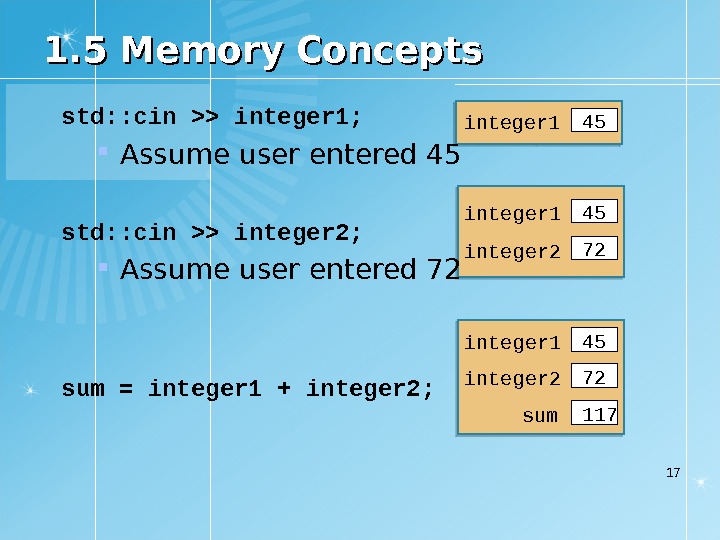
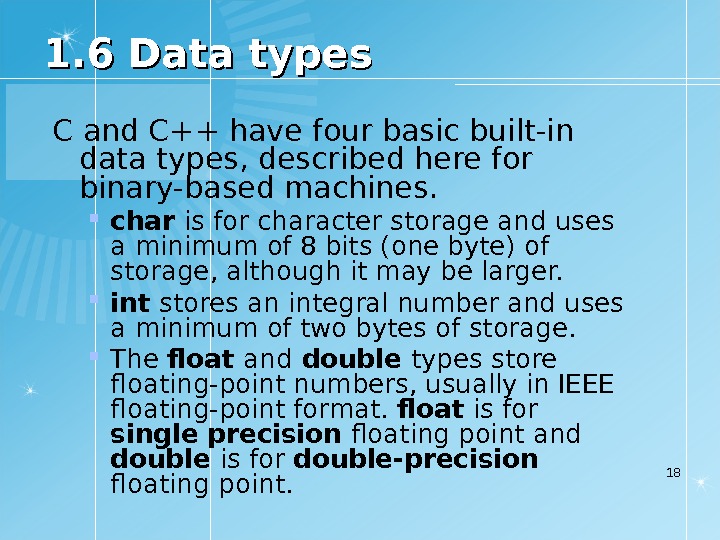
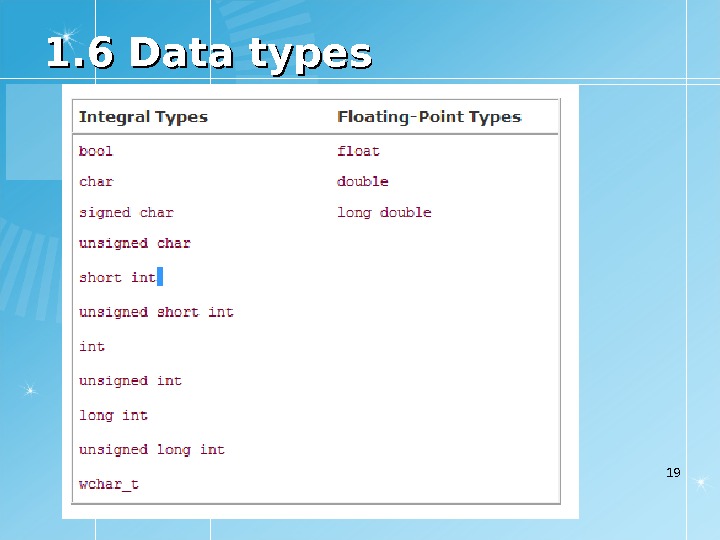
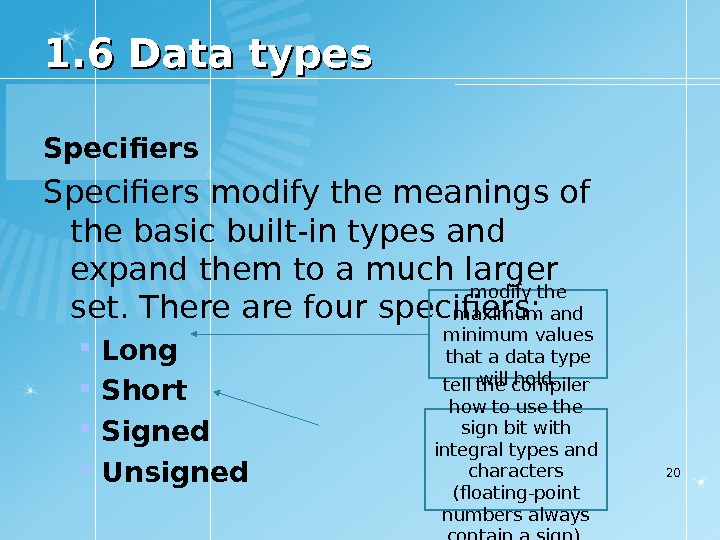
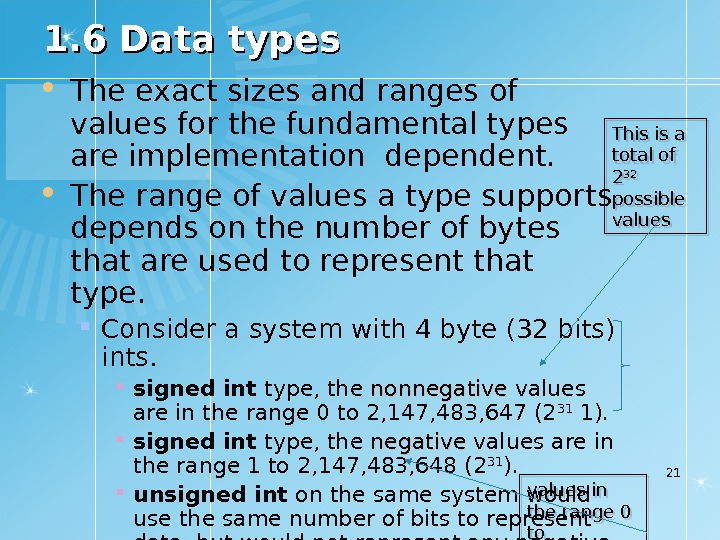
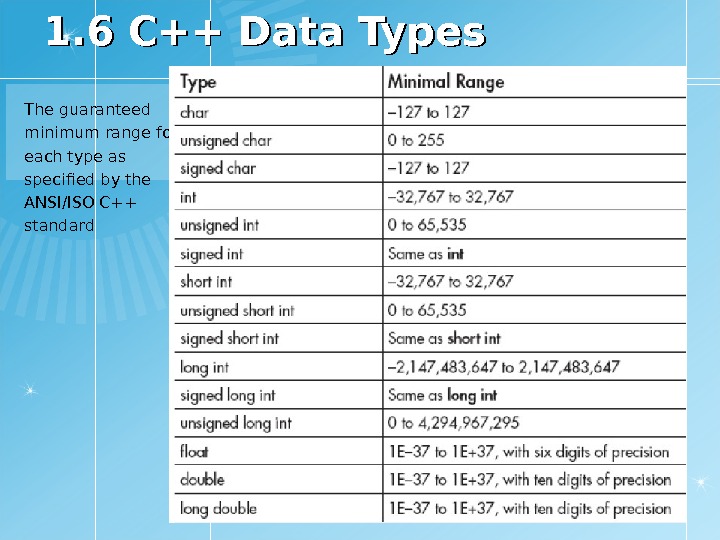
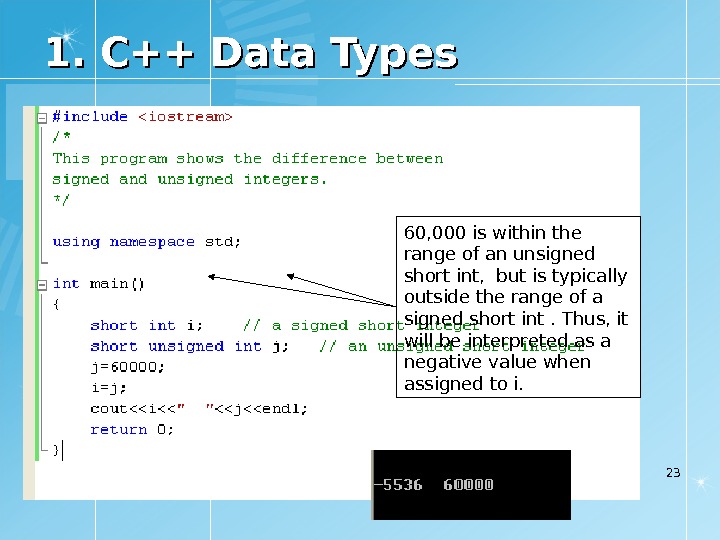
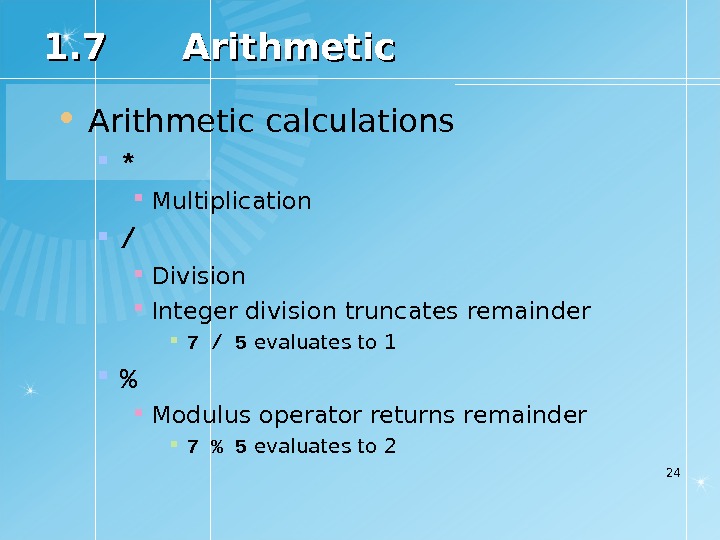
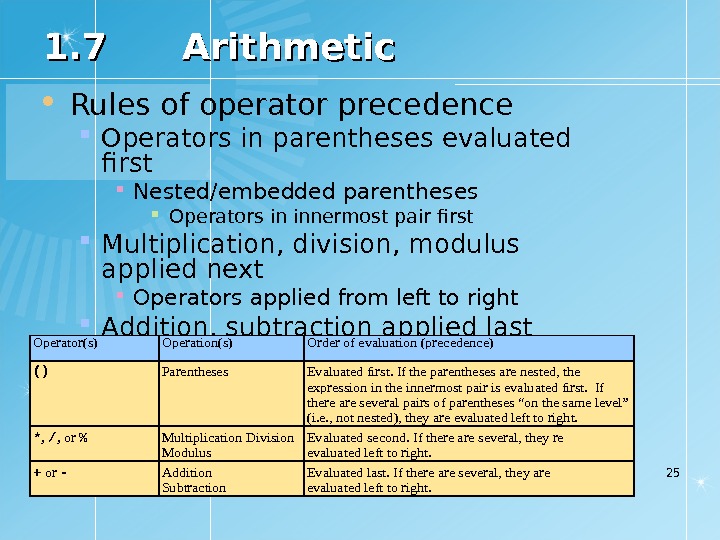
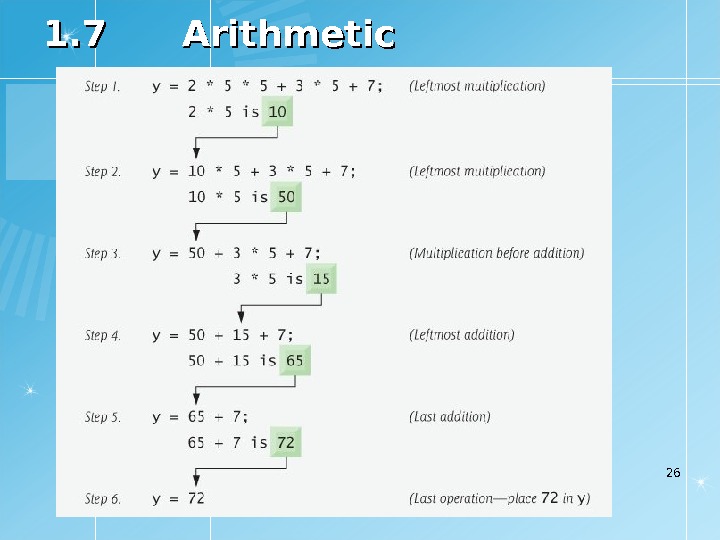
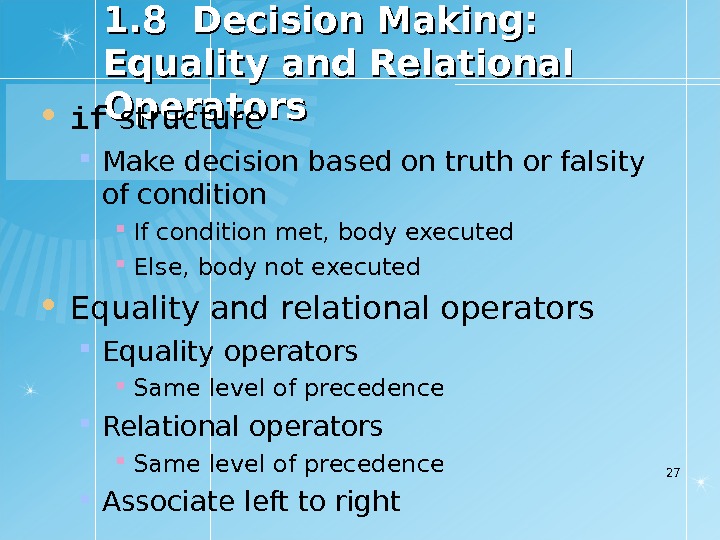
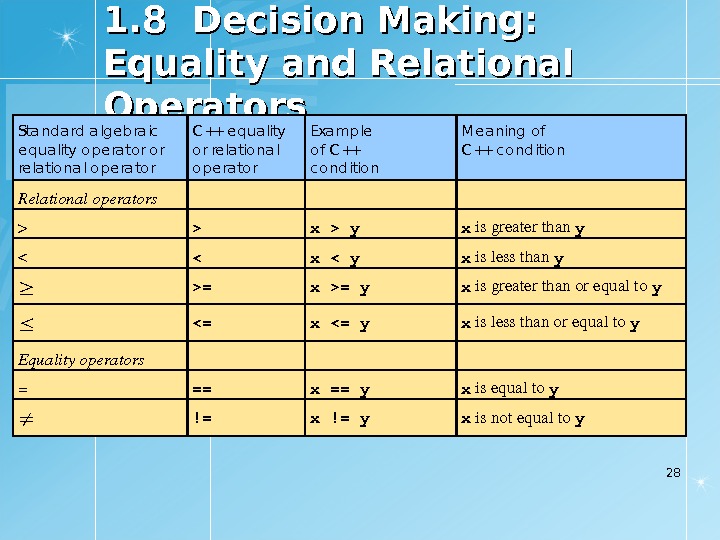
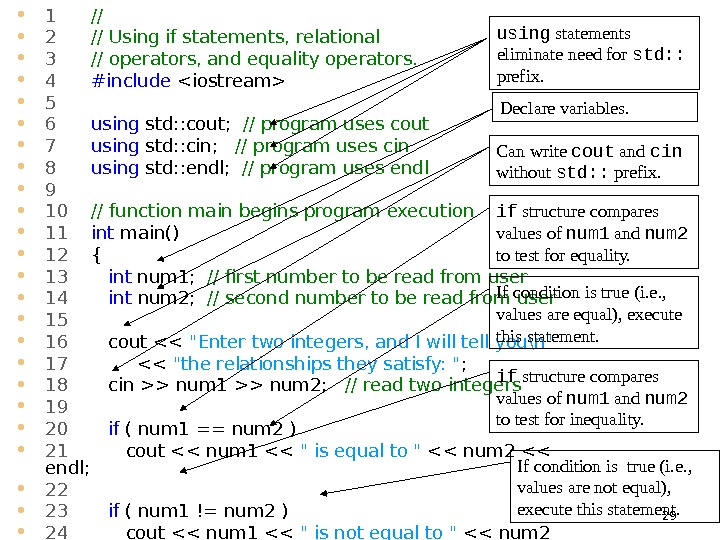
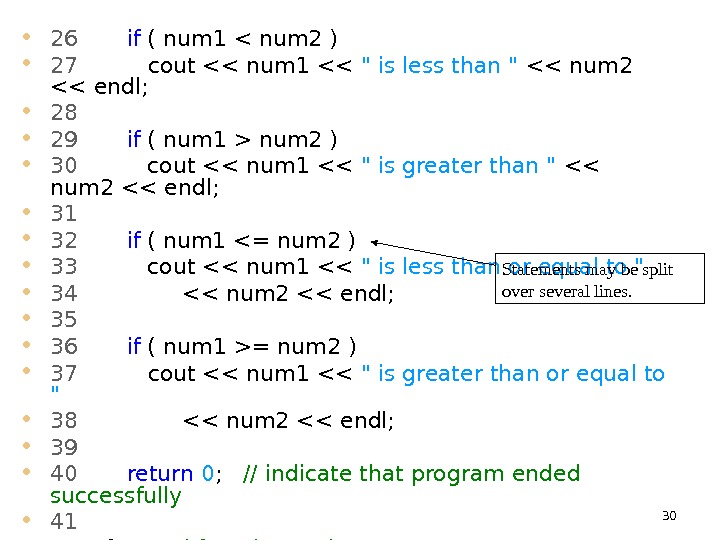
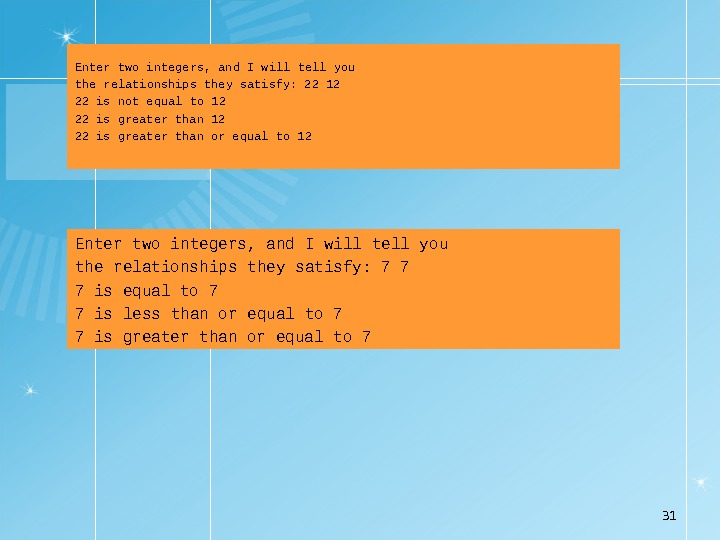
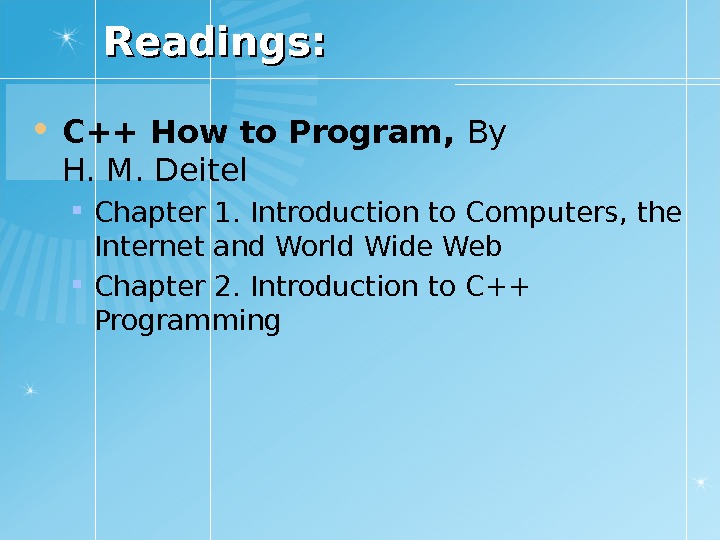

- Размер: 1.3 Mегабайта
- Количество слайдов: 33
Описание презентации Programming on Algorithmic Languages Week 1 1. по слайдам
 Programming on Algorithmic Languages Week
Programming on Algorithmic Languages Week
 1. 1 General Notes About C++ and This Course geared toward novice programmers Stress programming clarity C and C++ are portable languages Portability C and C++ programs can run on many different computers Compatibility Many features of current versions of C++ not compatible with older implementations
1. 1 General Notes About C++ and This Course geared toward novice programmers Stress programming clarity C and C++ are portable languages Portability C and C++ programs can run on many different computers Compatibility Many features of current versions of C++ not compatible with older implementations
 1. 1 General Notes About C++ and This Course What do you need? Books: C++ How to Program, Fifth (fourth) Edition By H. M. Deitel — Deitel & Associates C++A Beginner’s Guide By Herbert Schildt Absolute C++ By Walter Savitch IDE: Microsoft Visual C++ 2008 (Express or Professional editions) Sites: http: //cplus. com/ http: //e-practice. org http: //www. iitu. kz/ Your Mind (Brain)
1. 1 General Notes About C++ and This Course What do you need? Books: C++ How to Program, Fifth (fourth) Edition By H. M. Deitel — Deitel & Associates C++A Beginner’s Guide By Herbert Schildt Absolute C++ By Walter Savitch IDE: Microsoft Visual C++ 2008 (Express or Professional editions) Sites: http: //cplus. com/ http: //e-practice. org http: //www. iitu. kz/ Your Mind (Brain)
 1. 2 Introduction to C++ Programming C++ language Facilitates structured and disciplined approach to computer program design Following several examples Illustrate many important features of C++ Each analyzed one statement at a time Structured programming Object-oriented programming
1. 2 Introduction to C++ Programming C++ language Facilitates structured and disciplined approach to computer program design Following several examples Illustrate many important features of C++ Each analyzed one statement at a time Structured programming Object-oriented programming
 1. 3 Basics of a Typical C++ Environment C++ systems Program-development environment Language C++ Standard Library
1. 3 Basics of a Typical C++ Environment C++ systems Program-development environment Language C++ Standard Library
 1. 3 Basics of a Typical C++ Environment 6 Phases of C++ Programs: 1. Edit 2. Preprocess 3. Compile 4. Link 5. Load 6. Execute Primary Memory CPU takes each instruction and executes it, possibly storing new data values as the program executes. CPU. . . Program is created in the editor and stored on disk. Editor Disk Preprocessor program processes the code. Preprocessor Disk Compiler creates object code and stores it on disk. Disk Linker links the object code with the libraries, creates a. out and stores it on disk. Linker Disk Loader Primary Memory Loader puts program in memory. . . . Disk
1. 3 Basics of a Typical C++ Environment 6 Phases of C++ Programs: 1. Edit 2. Preprocess 3. Compile 4. Link 5. Load 6. Execute Primary Memory CPU takes each instruction and executes it, possibly storing new data values as the program executes. CPU. . . Program is created in the editor and stored on disk. Editor Disk Preprocessor program processes the code. Preprocessor Disk Compiler creates object code and stores it on disk. Disk Linker links the object code with the libraries, creates a. out and stores it on disk. Linker Disk Loader Primary Memory Loader puts program in memory. . . . Disk
 1. 3 Basics of a Typical C++ Environment Input/output cin Standard input stream Normally keyboard cout Standard output stream Normally computer screen cerr Standard error stream Display error messages
1. 3 Basics of a Typical C++ Environment Input/output cin Standard input stream Normally keyboard cout Standard output stream Normally computer screen cerr Standard error stream Display error messages
 1. 3 A Simple Program: Printing a Line of Text Comments Document programs Improve program readability Ignored by compiler Single-line comment Begin with // Preprocessor directives Processed by preprocessor before compiling Begin with #
1. 3 A Simple Program: Printing a Line of Text Comments Document programs Improve program readability Ignored by compiler Single-line comment Begin with // Preprocessor directives Processed by preprocessor before compiling Begin with #
 9 1 // Fig. 1. 2: fig 01_02. cpp 2 // A first program in C++. 3 #include 4 5 // function main begins program execution 6 int main() 7 { 8 std: : cout << "Welcome to C++!\n" ; 9 10 return 0 ; // indicate that program ended successfully 11 12 } // end function main Welcome to C++! Single-line comments. Preprocessor directive to include input/output stream header file . Function main appears exactly once in every C++ program. . Function main returns an integer value. Left brace { begins function body. Corresponding right brace } ends function body. Statements end with a semicolon ; . Name cout belongs to namespace std. Stream insertion operator. Keyword return is one of several means to exit function; value 0 indicates program terminated successfully.
9 1 // Fig. 1. 2: fig 01_02. cpp 2 // A first program in C++. 3 #include 4 5 // function main begins program execution 6 int main() 7 { 8 std: : cout << "Welcome to C++!\n" ; 9 10 return 0 ; // indicate that program ended successfully 11 12 } // end function main Welcome to C++! Single-line comments. Preprocessor directive to include input/output stream header file . Function main appears exactly once in every C++ program. . Function main returns an integer value. Left brace { begins function body. Corresponding right brace } ends function body. Statements end with a semicolon ; . Name cout belongs to namespace std. Stream insertion operator. Keyword return is one of several means to exit function; value 0 indicates program terminated successfully.
 1. 31 A Simple Program: Printing a Line of Text Standard output stream object std: : cout “ Connected” to screen << Stream insertion operator Value to right (right operand) inserted into output stream Namespace std: : specifies using name that belongs to “namespace” std: : removed through use of using statements Escape characters \ Indicates “special” character output
1. 31 A Simple Program: Printing a Line of Text Standard output stream object std: : cout “ Connected” to screen << Stream insertion operator Value to right (right operand) inserted into output stream Namespace std: : specifies using name that belongs to “namespace” std: : removed through use of using statements Escape characters \ Indicates “special” character output
 1. 31 A Simple Program: Printing a Line of Text. Escape Sequence Description \n Newline. Position the screen cursor to the beginning of the next line. \t Horizontal tab. Move the screen cursor to the next tab stop. \r Carriage return. Position the screen cursor to the beginning of the current line; do not advance to the next line. \a Alert. Sound the system bell. \\ Backslash. Used to print a backslash character. \» Double quote. Used to print a double quote character.
1. 31 A Simple Program: Printing a Line of Text. Escape Sequence Description \n Newline. Position the screen cursor to the beginning of the next line. \t Horizontal tab. Move the screen cursor to the next tab stop. \r Carriage return. Position the screen cursor to the beginning of the current line; do not advance to the next line. \a Alert. Sound the system bell. \\ Backslash. Used to print a backslash character. \» Double quote. Used to print a double quote character.
 12 1 // Fig. 1. 4: fig 01_04. cpp 2 // Printing a line with multiple statements. 3 #include 4 5 // function main begins program execution 6 int main() 7 { 8 std: : cout << "Welcome " ; 9 std: : cout << "to C++!\n" ; 10 11 return 0 ; // indicate that program ended successfully 12 13 } // end function main Welcome to C++! Multiple stream insertion statements produce one line of output.
12 1 // Fig. 1. 4: fig 01_04. cpp 2 // Printing a line with multiple statements. 3 #include 4 5 // function main begins program execution 6 int main() 7 { 8 std: : cout << "Welcome " ; 9 std: : cout << "to C++!\n" ; 10 11 return 0 ; // indicate that program ended successfully 12 13 } // end function main Welcome to C++! Multiple stream insertion statements produce one line of output.
 13 1 // Fig. 1. 5: fig 01_05. cpp 2 // Printing multiple lines with a single statement 3 #include 4 5 // function main begins program execution 6 int main() 7 { 8 std: : cout << "Welcome\nto\n\n. C++!\n" ; 9 10 return 0 ; // indicate that program ended successfully 11 12 } // end function main Welcome to C++! Using newline characters to print on multiple lines.
13 1 // Fig. 1. 5: fig 01_05. cpp 2 // Printing multiple lines with a single statement 3 #include 4 5 // function main begins program execution 6 int main() 7 { 8 std: : cout << "Welcome\nto\n\n. C++!\n" ; 9 10 return 0 ; // indicate that program ended successfully 11 12 } // end function main Welcome to C++! Using newline characters to print on multiple lines.
 1. 4 Variables Location in memory where value can be stored Common data types int — integer numbers char — characters double — floating point numbers Declare variables with name and data type before use integer 1; integer 2; int sum; Can declare several variables of same type in one declaration Comma-separated list integer 1, integer 2, sum;
1. 4 Variables Location in memory where value can be stored Common data types int — integer numbers char — characters double — floating point numbers Declare variables with name and data type before use integer 1; integer 2; int sum; Can declare several variables of same type in one declaration Comma-separated list integer 1, integer 2, sum;
 Variables Variable names Valid identifier Series of characters (letters, digits, underscores) Cannot begin with digit Case sensitive 151. 4 Variables
Variables Variable names Valid identifier Series of characters (letters, digits, underscores) Cannot begin with digit Case sensitive 151. 4 Variables
 1. 5 Memory Concepts Variable names Correspond to actual locations in computer’s memory Every variable has name, type, size and value When new value placed into variable, overwrites previous value Reading variables from memory nondestructive
1. 5 Memory Concepts Variable names Correspond to actual locations in computer’s memory Every variable has name, type, size and value When new value placed into variable, overwrites previous value Reading variables from memory nondestructive
 1. 5 Memory Concepts std: : cin >> integer 1; Assume user entered 45 std: : cin >> integer 2; Assume user entered 72 sum = integer 1 + integer 2; 17 integer 1 45 integer 2 72 sum
1. 5 Memory Concepts std: : cin >> integer 1; Assume user entered 45 std: : cin >> integer 2; Assume user entered 72 sum = integer 1 + integer 2; 17 integer 1 45 integer 2 72 sum
 1. 6 Data types C and C++ have four basic built-in data types, described here for binary-based machines. char is for character storage and uses a minimum of 8 bits (one byte) of storage, although it may be larger. int stores an integral number and uses a minimum of two bytes of storage. The float and double types store floating-point numbers, usually in IEEE floating-point format. float is for single precision floating point and double is for double-precision floating point.
1. 6 Data types C and C++ have four basic built-in data types, described here for binary-based machines. char is for character storage and uses a minimum of 8 bits (one byte) of storage, although it may be larger. int stores an integral number and uses a minimum of two bytes of storage. The float and double types store floating-point numbers, usually in IEEE floating-point format. float is for single precision floating point and double is for double-precision floating point.
 1. 6 Data types
1. 6 Data types
 1. 6 Data types Specifiers modify the meanings of the basic built-in types and expand them to a much larger set. There are four specifiers: Long Short Signed Unsigned 20 modify the maximum and minimum values that a data type will hold. tell the compiler how to use the sign bit with integral types and characters (floating-point numbers always contain a sign).
1. 6 Data types Specifiers modify the meanings of the basic built-in types and expand them to a much larger set. There are four specifiers: Long Short Signed Unsigned 20 modify the maximum and minimum values that a data type will hold. tell the compiler how to use the sign bit with integral types and characters (floating-point numbers always contain a sign).
 1. 6 Data types The exact sizes and ranges of values for the fundamental types are implementation dependent. The range of values a type supports depends on the number of bytes that are used to represent that type. Consider a system with 4 byte (32 bits) ints. signed int type, the nonnegative values are in the range 0 to 2, 147, 483, 647 (2 31 1). signed int type, the negative values are in the range 1 to 2, 147, 483, 648 (2 31 ). unsigned int on the same system would use the same number of bits to represent data, but would not represent any negative values. 21 This is a total of 2 32 possible values in the range 0 to 4, 294, 967, 2 95 (2 32 1)
1. 6 Data types The exact sizes and ranges of values for the fundamental types are implementation dependent. The range of values a type supports depends on the number of bytes that are used to represent that type. Consider a system with 4 byte (32 bits) ints. signed int type, the nonnegative values are in the range 0 to 2, 147, 483, 647 (2 31 1). signed int type, the negative values are in the range 1 to 2, 147, 483, 648 (2 31 ). unsigned int on the same system would use the same number of bits to represent data, but would not represent any negative values. 21 This is a total of 2 32 possible values in the range 0 to 4, 294, 967, 2 95 (2 32 1)
 1. 6 C++ Data Types The guaranteed minimum range for each type as specified by the ANSI/ISO C++ standard
1. 6 C++ Data Types The guaranteed minimum range for each type as specified by the ANSI/ISO C++ standard
 1. C++ Data Types 2360, 000 is within the range of an unsigned short int, but is typically outside the range of a signed short int. Thus, it will be interpreted as a negative value when assigned to i.
1. C++ Data Types 2360, 000 is within the range of an unsigned short int, but is typically outside the range of a signed short int. Thus, it will be interpreted as a negative value when assigned to i.
 1. 7 Arithmetic calculations * Multiplication / Division Integer division truncates remainder 7 / 5 evaluates to 1 % Modulus operator returns remainder 7 % 5 evaluates to
1. 7 Arithmetic calculations * Multiplication / Division Integer division truncates remainder 7 / 5 evaluates to 1 % Modulus operator returns remainder 7 % 5 evaluates to
 1. 7 Arithmetic Rules of operator precedence Operators in parentheses evaluated first Nested/embedded parentheses Operators in innermost pair first Multiplication, division, modulus applied next Operators applied from left to right Addition, subtraction applied last Operators applied from left to right 25 Operator(s) Operation(s) Order of evaluation (precedence) () Parentheses Evaluated first. If the parentheses are nested, the expression in the innermost pair is evaluated first. If there are several pairs of parentheses “on the same level” (i. e. , not nested), they are evaluated left to right. *, /, or % Multiplication Division Modulus Evaluated second. If there are several, they re evaluated left to right. + or — Addition Subtraction Evaluated last. If there are several, they are evaluated left to right.
1. 7 Arithmetic Rules of operator precedence Operators in parentheses evaluated first Nested/embedded parentheses Operators in innermost pair first Multiplication, division, modulus applied next Operators applied from left to right Addition, subtraction applied last Operators applied from left to right 25 Operator(s) Operation(s) Order of evaluation (precedence) () Parentheses Evaluated first. If the parentheses are nested, the expression in the innermost pair is evaluated first. If there are several pairs of parentheses “on the same level” (i. e. , not nested), they are evaluated left to right. *, /, or % Multiplication Division Modulus Evaluated second. If there are several, they re evaluated left to right. + or — Addition Subtraction Evaluated last. If there are several, they are evaluated left to right.
 1. 7 Arithmetic
1. 7 Arithmetic
 1. 8 Decision Making: Equality and Relational Operators if structure Make decision based on truth or falsity of condition If condition met, body executed Else, body not executed Equality and relational operators Equality operators Same level of precedence Relational operators Same level of precedence Associate left to right
1. 8 Decision Making: Equality and Relational Operators if structure Make decision based on truth or falsity of condition If condition met, body executed Else, body not executed Equality and relational operators Equality operators Same level of precedence Relational operators Same level of precedence Associate left to right
 1. 8 Decision Making: Equality and Relational Operators Sta nd a rd a lgeb ra ic eq ua lity op era tor or rela tiona l op era tor C ++ eq ua lity or rela tiona l op era tor Exa mple of C ++ c ond ition M ea ning of C ++ c ond ition Relationaloperators > > x>y x isgreaterthan y < < x= x>=y x isgreaterthanorequalto y <= x<=y x islessthanorequalto y Equalityoperators = == x==y x isequalto y != x!=y x isnotequalto y
1. 8 Decision Making: Equality and Relational Operators Sta nd a rd a lgeb ra ic eq ua lity op era tor or rela tiona l op era tor C ++ eq ua lity or rela tiona l op era tor Exa mple of C ++ c ond ition M ea ning of C ++ c ond ition Relationaloperators > > x>y x isgreaterthan y < < x= x>=y x isgreaterthanorequalto y <= x<=y x islessthanorequalto y Equalityoperators = == x==y x isequalto y != x!=y x isnotequalto y
 1 // 2 // Using if statements, relational 3 // operators, and equality operators. 4 #include 5 6 using std: : cout; // program uses cout 7 using std: : cin; // program uses cin 8 using std: : endl; // program uses endl 9 10 // function main begins program execution 11 int main() 12 { 13 int num 1; // first number to be read from user 14 int num 2; // second number to be read from user 15 16 cout << "Enter two integers, and I will tell you\n" 17 <> num 1 >> num 2; // read two integers 19 20 if ( num 1 == num 2 ) 21 cout << num 1 << " is equal to " << num 2 << endl; 22 23 if ( num 1 != num 2 ) 24 cout << num 1 << " is not equal to " << num 2 << endl; 25 using statements eliminate need for std: : prefix. Can write cout and cin without std: : prefix. Declare variables. if structure compares values of num 1 and num 2 to test for equality. If condition is true (i. e. , values are equal), execute this statement. if structure compares values of num 1 and num 2 to test for inequality. If condition is true (i. e. , values are not equal), execute this statement.
1 // 2 // Using if statements, relational 3 // operators, and equality operators. 4 #include 5 6 using std: : cout; // program uses cout 7 using std: : cin; // program uses cin 8 using std: : endl; // program uses endl 9 10 // function main begins program execution 11 int main() 12 { 13 int num 1; // first number to be read from user 14 int num 2; // second number to be read from user 15 16 cout << "Enter two integers, and I will tell you\n" 17 <> num 1 >> num 2; // read two integers 19 20 if ( num 1 == num 2 ) 21 cout << num 1 << " is equal to " << num 2 << endl; 22 23 if ( num 1 != num 2 ) 24 cout << num 1 << " is not equal to " << num 2 << endl; 25 using statements eliminate need for std: : prefix. Can write cout and cin without std: : prefix. Declare variables. if structure compares values of num 1 and num 2 to test for equality. If condition is true (i. e. , values are equal), execute this statement. if structure compares values of num 1 and num 2 to test for inequality. If condition is true (i. e. , values are not equal), execute this statement.
 30 26 if ( num 1 < num 2 ) 27 cout << num 1 << " is less than " << num 2 < num 2 ) 30 cout << num 1 << " is greater than " << num 2 << endl; 31 32 if ( num 1 <= num 2 ) 33 cout << num 1 << " is less than or equal to " 34 << num 2 <= num 2 ) 37 cout << num 1 << " is greater than or equal to " 38 << num 2 << endl; 39 40 return 0 ; // indicate that program ended successfully 41 42 } // end function main Statements may be split over several lines.
30 26 if ( num 1 < num 2 ) 27 cout << num 1 << " is less than " << num 2 < num 2 ) 30 cout << num 1 << " is greater than " << num 2 << endl; 31 32 if ( num 1 <= num 2 ) 33 cout << num 1 << " is less than or equal to " 34 << num 2 <= num 2 ) 37 cout << num 1 << " is greater than or equal to " 38 << num 2 << endl; 39 40 return 0 ; // indicate that program ended successfully 41 42 } // end function main Statements may be split over several lines.
 31 Enter two integers, and I will tell you the relationships they satisfy: 7 7 7 is equal to 7 7 is less than or equal to 7 7 is greater than or equal to 7 Enter two integers, and I will tell you the relationships they satisfy: 22 12 22 is not equal to 12 22 is greater than or equal to
31 Enter two integers, and I will tell you the relationships they satisfy: 7 7 7 is equal to 7 7 is less than or equal to 7 7 is greater than or equal to 7 Enter two integers, and I will tell you the relationships they satisfy: 22 12 22 is not equal to 12 22 is greater than or equal to
 Readings: C++ How to Program, By H. M. Deitel Chapter 1. Introduction to Computers, the Internet and World Wide Web Chapter 2. Introduction to C++ Programming
Readings: C++ How to Program, By H. M. Deitel Chapter 1. Introduction to Computers, the Internet and World Wide Web Chapter 2. Introduction to C++ Programming
 33 Thanks for your attention!
33 Thanks for your attention!

